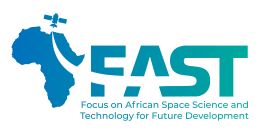FAST4Future Online Seminar via Microsoft Teams
Topic: Recent Developments in Blazar Unification
Presenter: Prof. F.C. Odo
Affiliation of presenter: Department of Physics and Astronomy, University of Nigeria, Nsukka. Nigeria
Email address of the presenter: finbarr [dot] odo [at] unn [dot] edu [dot] ng (finbarr[dot]odo[at]unn[dot]edu[dot]ng)
Moderator: Prof. Taye Demissie (University of Botswana)
Email of FAST4Future: info [at] cesst [dot] org (info[at]cesst[dot]org)
August 29, 2024, 15:00 CAT
Abstract
The distributions of observed γ-ray properties, as well as orientation parameters of a sample of Fermi-LAT AGNs were used to investigate the hypothesis that γ-NLS1 objects are beamed sources with γ-ray emitting axes inclined at close angles to the line of sight. Based on these parameters we investigate the relationship between γ-NLS1s and other subclasses of γ-ray emitting jetted AGNs. Results show that γ-NLS1s are more highly beamed than both FSRQs and BL Lacs with mean value of core-dominance parameter Rγ ~ 9507. γ-NLS1s and jetted Seyfert galaxies are continuous in distribution of the orientation parameter with average cone angles ϕm ~ 8o and 44o respectively. Furthermore, the spectral energy distribution of γ-NLS1 is comparable to those of FSRQs and BL Lacs suggestive that γ-NLS1s and blazars form a continuous spectral sequence. There is a significant anti-correlation (r ~ -0.9) between the γ-ray dominance (Dγ) and γ-ray luminosity. There is a strong dependence of Dγ on redshift (r ~ -0.7) suggestive that Dγ is more sensitive to environmental factors than intrinsic γ-ray luminosity. The results suggest that γ-NLS1s are highly beamed γ-ray sources whose de-beamed counterparts can be found among Seyfert galaxy populations.
Biography
 Finbarr Chidi, Odo is a professor of Physics and Astronomy at the University of Nigeria, Nsukka He earned his B.Sc (Physics) in 1998, M. Sc (Astrophysics) in 2006 and PhD (Astrophysics) in 2012, with specialty in radio astronomy and cosmology. Between 2006 and 2008, Finbarr served as a lecturer at the Federal College of Technical Education, Umunze, Nigeria and later as a Research Fellow at National Centre for Energy Research and Development, Nsukka. In 2016, Prof. Odo joined University of Nigeria, Nsukka as a Senior Lecturer and rose to Professor in 2023. Finbarr is a regular instructor at the Pan-African Summer School for Emerging Astronomers and a member of the Consortium board of Africa off-Earth Network.
Finbarr Chidi, Odo is a professor of Physics and Astronomy at the University of Nigeria, Nsukka He earned his B.Sc (Physics) in 1998, M. Sc (Astrophysics) in 2006 and PhD (Astrophysics) in 2012, with specialty in radio astronomy and cosmology. Between 2006 and 2008, Finbarr served as a lecturer at the Federal College of Technical Education, Umunze, Nigeria and later as a Research Fellow at National Centre for Energy Research and Development, Nsukka. In 2016, Prof. Odo joined University of Nigeria, Nsukka as a Senior Lecturer and rose to Professor in 2023. Finbarr is a regular instructor at the Pan-African Summer School for Emerging Astronomers and a member of the Consortium board of Africa off-Earth Network.
Microsoft Teams: Join the meeting now
Meeting ID: 364 352 358 93
Passcode: MKNQg
https://teams.microsoft.com/v2/?meetingjoin=true
August 29, 2024, 15:00 CAT



